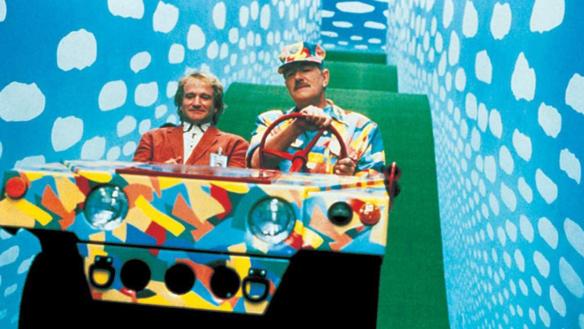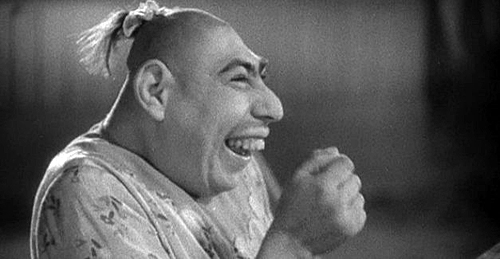
“Oh! just, subtle, and mighty opium! that to the hearts of poor and rich alike, for the wounds that will never heal, and for ‘the pangs that tempt the spirit to rebel,’ bringest an assuaging balm; eloquent opium!”
Now we could argue all day about whether or not this film is actually good. Whether it was politically correct in its portrayal of Asians and Asian-Americans. Whether it was sensitive to the actual tragedies of real human sex trafficking. Whether it even accurately depicts the effects of opium. At the end of the day Confessions of an Opium Eater (1962), starring Vincent Price (Theater of Blood, House of Wax, Comedy of Terrors, House on Haunted Hill, The Tingler, Edward Scissorhands) and a mostly Asian cast, it’s just too weird of a movie not to geek out about.
Confessions of an Opium Eater, directed by exploitation director Albert Zugsmith and apparently very liberally inspired by the memoirs of Thomas De Quincey, is a weird bit of exotic thriller pulp. It should rank alongside Coke Ennyday and the Mystery of the Leaping Fish* (1916) for weird, vintage drug movies or Big Trouble in Little China (1986) for Chinatown-is-magic action movies.
*Oh, it’s a real movie. Douglas Fairbanks plays a pseudo-Sherlock Holmes spoof with super Popeye crime-fighting powers whenever he snorts cocaine. The best bits are when he makes the bad guys O.D. and they shoot through the roof. For 1916, it’s hilariously cavalier about drug use.
The movie begins with a somber, reflective voice-over narration as we see a Chinese junk drifting in the mists of a murky, bathtub sea. We get the credits and a skeleton washed up on a forgotten beach. Then we get almost 10 straight minutes of no dialogue; just drugged up Chinese women being loaded into a net and transplanted from ship to shore, where a small hook-filled battle erupts. There’s a lot of desperation and suspense and mystery already. Also a bad guy gets murdered by a random horse, which is always great.
Vincent Price (perhaps woefully miscast, but just maybe his out-of-place poetic, world-weary melancholy and hammy energy are actually what makes this movie so deliciously strange) plays Gilbert de Quincey, a mysterious turn-of-the-century sailor man with a cryptic tie to the Orient. De Quincey, a passive character who wanders about as if in a sort of dream, gets mixed up in the Tong wars going on in the nineteenth century streets of San Francisco’s Chinatown. He meets a host of culturally sensitive Chinese characters such as the sneaky, deceitful merchant; the manipulative dragon lady; the bribe-able opium dealer; and the helpless lotus flower waif who needs a white man to save her from sex slavery. Like I said, it might not be the most P.C. flick, but, to its credit, the cast is nearly all an authentic Chinese cast (minus one dwarf, but we’ll get back to her later). The cheesy broken English is made even weirder when they awkwardly speak it when Vincent Price is not around (it’s sad because you know actors like Philip Ahn speak perfect English and they have to dumb it all down) and even sillier when Vincent Price talks to them using flowery Shakespearean language meant to evoke deep philosophical sophistication. Price waxes poetic like a jackass while his Asian co-stars are lacking definite articles and proper verb conjugation. Yet never a miscommunication.
De Quincey gets captured and lackadaisically falls for a lovely Chinese girl named Lotus (June Kyoto Lu) whom he rescues from axe-murderers. A nice secret dumbwaiter getaway and sewer battle ensues. He also meets a power-hungry Asian seductress, Ruby Lo (played very well by Linda Ho). She is the true puppet master of the devilish proceedings of Chinatown’s seedy underbelly and, once she gets enough treasure and opium, she will return to China and lead an army…that will do…something.
It goes without saying that Ruby Lo is a way more interesting that Lotus (and, by de facto, much sexier), but the real intriguing character is the fearless, tough-talking Chinese midget named Child (played by Yvonne Moray who also appeared in Wizard of Oz and Terror of Tiny Town). She’s like Zelda Rubinstein and Linda Hunt with even more chutzpah. She’s seen it all and doesn’t really care what the world has to say. She’s feisty and optimistic—even when facing certain death. She’s pretty much the best character ever. I liked the movie a lot before she shows up (arriving floating down a dark corridor in a suspended bamboo cage), but after that I loved the movie. And she’s not the only little person in this movie. Angelo Rossitto (Freaks, Mad Max Beyond the Thunderdome) has a bit part as a newspaperman in the beginning.
Vincent Price is known for playing spooky killers and tortured killers and obsessed killers (he’s got a bit of a persona), so seeing him as a butthole action guy is kind of surreal. Anyway, this movie is weird for a number of reasons, Vincent Price being an action guy not least of them. The majority of the cast being Asian is unique for an early ’60s Hollywood movie (almost no objectionable “yellow-face”). The dialogue has only two modes: Vincent Price ham poetry and stilted Chinaman-ese. It really sort of fetishizes human sex trafficking and by that I mean it doesn’t exactly condone it (only the bad guys are involved in it), but at the same time the film tries to make it sexy. Between the floating bamboo cages, steamy dance numbers, seeming disposable nature of women, it’s all rather fetishistic. It’s hard to say your film is condemning using women as sex props when your movie pretty much uses them as sex props. I like secret trapdoors and hidden passageways and cool torture devices, but maybe it’s all too campy for something as serious as human sex trafficking. The atmosphere of the movie, aided by Price’s creepy, condescending line delivery and narration readings, is very eerie and dreamlike. The musical score helps that feeling too. The music sounds like vaguely hypnotic theremin tones. Then occasionally all music and sound will drop out and it’ll feel even weirder. There is really only one scene where our hero actually smokes opium…AND THAT SCENE IS ABSOLUTELY BRILLIANT.
Skulls and sawfish parade by along with a host of other phantasmagoric imagery and nightmarishly distorted countenances during his trip…and then he wakes up and we get a 1960s soundless stoner action scene with Chinese axe-throwers and Vincent Price running around in late 1800s ‘Frisco. It’s way too cool to even be real. Even the ending of this movie feels bizarre, like we’re all stuck in suspended animation. Does he die? What happens? Where are they going? Did they kill the bad guy? What’s happening? Who was the random guy at the end who was in disguise? Is it over?
I really don’t know what else to say. Watch this movie if you can find it. It’s weird. If you’ve read any of my reviews of other old movies you’d know I’m exceedingly forgiving of racism, sexism, and cheesiness in my vintage pulp. Take it all for what it is. Don’t be offended. It’s a peculiar and unflattering history lesson to watch these old movies. Moral of the story: locate Confessions of an Opium Eater and enjoy all it’s weird, uncomfortable, erotic dreaminess. Maybe make it a double feature with Reefer Madness (1936).
Picture References:
http://www.coffeecoffeeandmorecoffee.com/archives/2013/10/confessions_of.html
http://www.midnightonly.com/2013/04/21/confessions-of-an-opium-eater-1962/
http://scalisto.blogspot.kr/2013/06/albert-zugsmith-confessions-of-opium.html





































































